I have had this post in planning for a few months but today is the day for finally sharing with you three of my favourite art books.
The really interesting thing about all three is that they do not directly relate to the way that I currently sketch. And they are not technique based books with lots of step-by-step demonstrations.
The reason they are my favourite is because they explain concepts and make me think.
This isn’t a detailed book review of each but simply an overview containing what my ‘off the top of my head’ takeaway thought is right at the moment – months and months after reading each book.
Perhaps in some ways this might be a more interesting way to review a book? Articulating what I remember about a book and I have absorbed into my work. It might not be as accurate as if I had just finished reading it but it is a sign of its impact.
I suggest that you check out the Amazon reviews for more details – or if you have read these books, please leave comments below in this post for others.
Charles Hawthorne:
Hawthorne on Painting
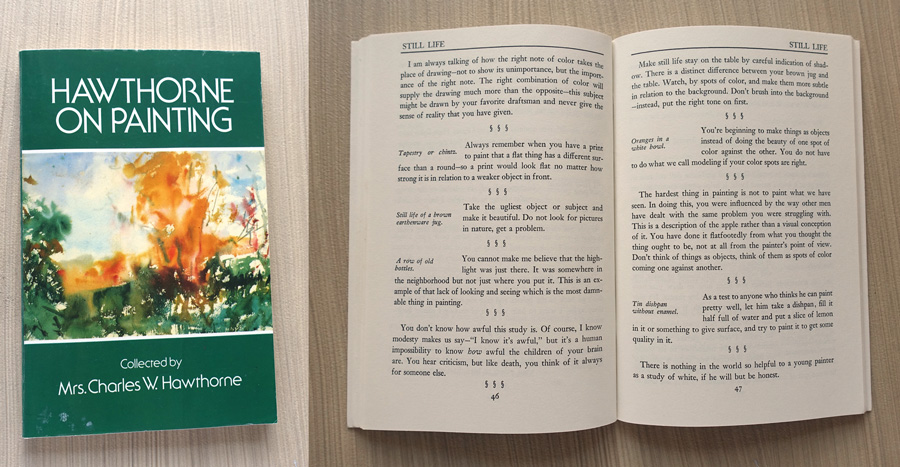
I have been reading and re-reading this book since July 2012 when Anne Watkins in NYC told me about it. I have packed this little book in my suitcase on many trips (I now have a kindle version as well) and would often pick it up and read a few sentences at the end of a big day out sketching. The book contains a selection of quotes from Charles Hawthorne to his students about painting.
The book is focused on shape-based painting, not drawing. When I first started reading it, I was addicted to line so it was a completely different way of thinking. Now that I am more into shapes, I get much more out of this book, but even in the early days of reading it, Hawthorne’s thoughts were inspiring.
My big takeaway from the book: Painting is simply one coloured shape next to another.
Tom Hoffmann:
Watercolor Painting: A Comprehensive Approach to Mastering the Medium
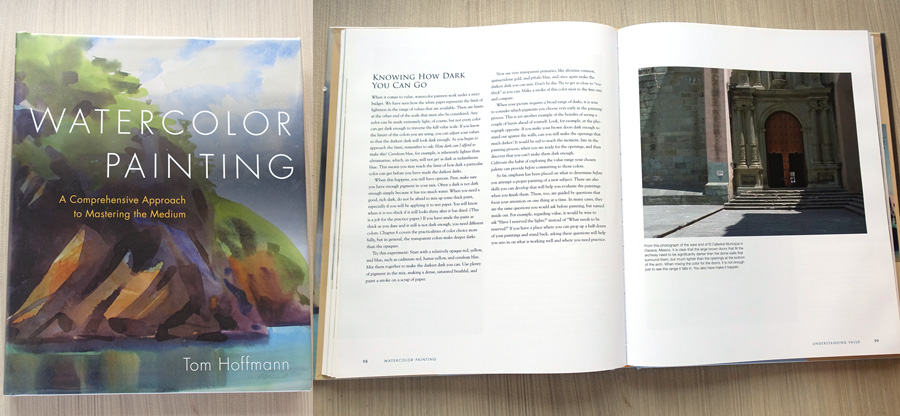
I bought this book after a conversation with Shari Blaukopf in Barcelona in 2013 – she is a mega-fan of Tom – so when I got home looked him up and ordered his book straight away. Since starting to write this post, another sketching friend, Suhita Shirodkar, recently did one of Tom’s workshops and blogged about it here.
This is not a how-to watercolour book as such, although there are a few step by step demonstrations included, so I think it is best suited for someone who has some experience. It is a book for thinking about watercolour with lots of food for thought.
The whole book is great but I particularly remember the chapters on seeing in layers and sharing control of wetness – what great chapter headings, hey? I included a long quote from the book in this recent blog post.
I really need to re-read it again soon and share more insights with you.
My big takeaway message of the book: Watercolour looks spontaneous but requires a lot of planning.
Walt Stanchfield:
Drawn from Life Volume 1 and Volume 2
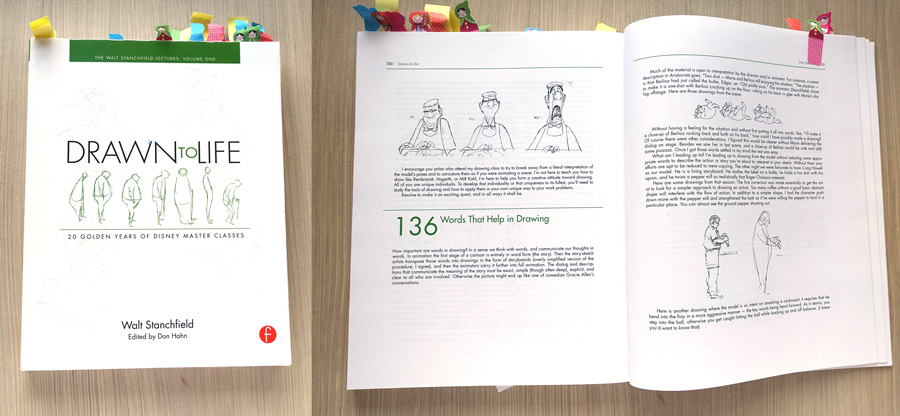
And finally, two volumes of a book that you can download a part of the book PDF version for free here (the only way to get the full content is to buy the hard copy).
Early in 2015 while having a coffee with Chantal Vincent, she mentioned looking at the work of animators. That was enough to start me thinking: animators design movement a little bit like architects design buildings – this includes having understanding of structure and then using it to tell a story. I then started googling and lots of people referred to the handouts of Walt Stanchfield from his Gesture Masterclasses at Disney Studios.
I can’t tell you how wonderful these books are – not just in regard to capturing gesture but also general creativity and drawing. I started reading them just after putting together the content for my Foundations online course. One of the big ideas I introduced in that course is how feeling edges, abstracting shapes and constructing volumes are different ways of seeing and that they work together. Aside: this is what I will be teaching in my upcoming workshop at the USK Symposium in Manchester and in my SketchingNow Buildings course in September.
I had a lot of half formed ideas that didn’t make it into the course, ideas about the ways in which constructing volumes (a more left brain approach) can really strengthen your work and that often it’s not just a matter of drawing what you see. This is a major part of Walt’s teaching – the book is full of his quick sketches correcting the ‘students’ drawings to show how to strengthen the story by modifying the gesture. This involves the ability to deconstruct the subject mentally and then put it together from a slightly different viewpoint. So it was unbelievably inspiring to read a master artist articulate his theories of using both left and right brain when drawing, which was where my ideas were heading but I had thought they might be a bit too radical!
While used in the context of the human figure, I think of this Walt quote all the time when I sketch buildings: “Perspective should be felt not diagrammed.”
Oh! there is so much in these books – I am certainly not doing them justice in these few lines. So if any of my readers have read these books, I would love you to leave a comment sharing what you love about them most, so others can get a better idea of the rich content.
Takeaways: Using both sides of the brain when you sketch, not drawing what you see but modifying it to tell the story better… and much more. I really need to re-read this book again soon.
So there you have it, three perhaps slightly surprising ‘favourite art books’… but if you know me well, you will understand that I love thinking about art and this selection will make more sense.
So, what about you? What are your favourite books?
Have you read any of these three books? did you enjoy them?

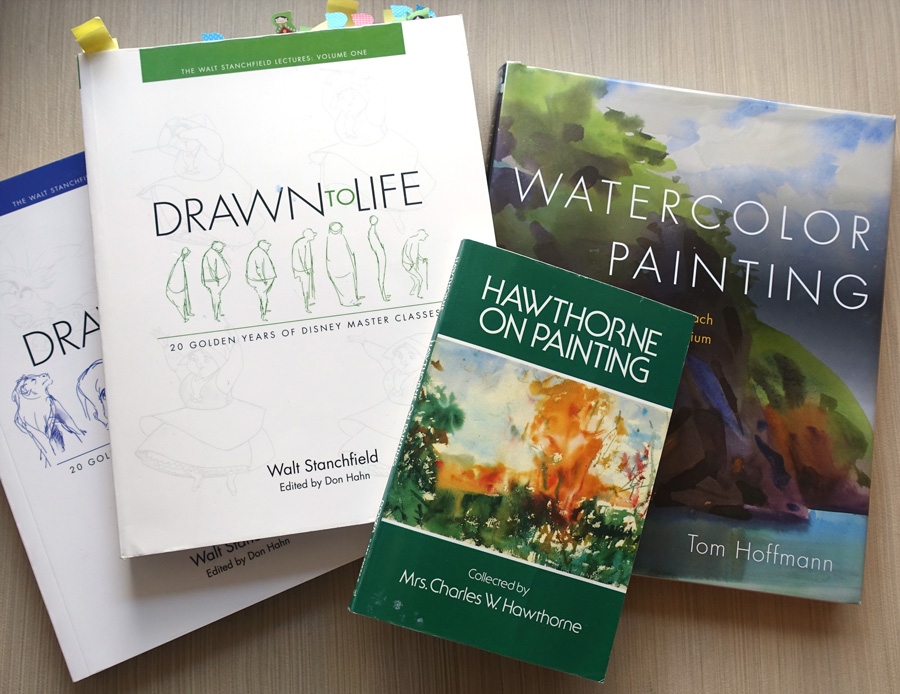



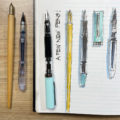
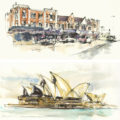
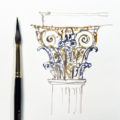
21 Comments
Thanks for sharing, Liz.
my pleasure Helena!
These look marvelous, Liz! And my favorite art book is Nick Meglin’s Drawing from Within…iconoclastic, inspiring, delightful!
ah! Nick’s book is a good read too!
Hi, Liz,
Can you, or anyone tell me if in the book of Tom Hoffman, there is info on what colors he uses to make his SHADOWS. Ex on pages 68-69?
Would be very helpfull to not only understand the general view, but to also be abble to understand HOW to do it!
Louise
hi Louise- I don’t think there are any pigments referenced in the book. It is all about the concepts not the specifics.
I have Tom Hoffmann’s book and my summer project is to go through the whole thing and put all his advice into practice, using it like a workbook. I love the way he gets you to think about why you should do stuff, not just what you should do. And his advice about understanding which of the (three?) layers of your painting is the most important for telling the story and that you can be really loose with the first two layers if the darkest darks are all that is needed to define your painting. He has a very useful website too where he notes all of the lessons for his students, and much of this is repeated in more detail in his book.
I’m going to have a look at your other 2 recommendations too. Thanks Liz!
Hi Sandra thanks so much for this extra bit from the Hoffmann book. I do need to read it again and share some more insights. I got a little carried away with Stanchfield didn’t I? that is what is on my mind at the moment, but need to foucs back on my painting soon!
I just got a copy of the book Hawthorne on Painting when seeing it recommended by Susan Sarback who does beautiful work with color and light in her paintings; I have been sharing quotes with my friend MaryBeth as we prepare for our Italy sketching trip. Love how seemingly random things are all connected.
ah! lots of quotable quotes… that is why I love the book so much!
I have all 3 books and they’re among my top reads right now. ( I believe atleast 1 of the 3 was recommended by you, thank you!) I love books that make you think and give you concepts to understand and then incorporate into your work: while that’s much harder than step-by-step books, I find that if I put in the work to really understand a concept rather than reproduce the work, the learning is truly internalized, sticks with me better, and eventually gets incorporated into my own work.
A book I am totally loving reading is ‘FreePlay: Improvisation in Life and Art’ ( https://www.amazon.com/Free-Play-Improvisation-Life-Art-ebook/dp/B001ROAKG2?ie=UTF8&btkr=1&ref_=dp-kindle-redirect) . While the author mainly references jazz, I find the concepts and thinking fascinating: after all, both urban sketching and working in a medium as fluid as watercolors means you have to love to improvise!
wow! sounds greats!
This is a great thought provoking blog. I’ve not read any of the books you mentioned but just having completed the Edges Course I find that perhaps I could now understand better what I was doing and how I was doing it. A few months ago none of what any of these artists said would have been understood. Looking forward to the September course for these same reasons. Books I have read and partially digested include those by Jean Haines and William Cooper because I was attracted to their styles and wanted to learn more. What I have found is that it is easier to learn by watching someone else (i.e. you) when you can watch and listen to the why of it at the same time. I love your blogs. They are thoughtful, innovative, inspirational and chock full of usable information. Thank you.
thanks Carole, I agree! I prefer to water a DVD of current painters and then refer to the book later as a quick reference. These books however because they are mainly words satisfy in a mental way, affecting how you think rather than picking up technique. Does that help. But in personal technique and thoughts is the best!
I saw the Stanchfield books on your shelf when I took the Edges course and ordered them. As you say, they are amazing, as is Ron Husband’s Quick Sketching book from the same publisher. From what I can see, the PDF you reference is not the same, though there is considerable overlap. The books seem to present Stanchfields mini-tutorial series while the PDF is a gesture drawing book. The PDF is about 1/3 the length of the two Drawn to Life volumes. — Larry
Oops! Thanks Larry for the correction about the PDF file. I have just updated the blog post to reflect that.
Looking at books on my middle shelf is a good way to see what are my top books. The rest of the shelves are less reliable, but the one directly behind me are where I put the best ones! Of course often some more books are scattered around the place as I am referring to them at the time.
Thank you for this informative post and these recommendations. Recently, I enjoyed A Short Book About Drawing by Andrew Marr. Personal experiences, some history and a lot of motivation to Just Draw!
Thank you! The pdf looks excellent. I can’t wait to read and try all of them!
I’m late to this discussion, but my favorite art book is “Composition of Outdoor Painting,” by California Impressionist Edgar Payne. In the 1920’s Payne painted the California coast, and later the Sierra Madre. The book is available through DeRu’s Fine Arts, in Bellflower CA.
Love love love Urban Watercolor Sketching by Felix Scheinberger and also Heart to Hands Bead Embroidery by Robin Atkins, even though I don’t do beading. It’s about finding inspiration, telling stories through art, and working in series.
Love your blog and can’t wait for your book, too!
thanks Donna for the suggestions. Yes Felix’s work is great! Thanks too for the kind words about blog and book
NEWSLETTER
Subscribe for first notification of workshop + online classes and more.